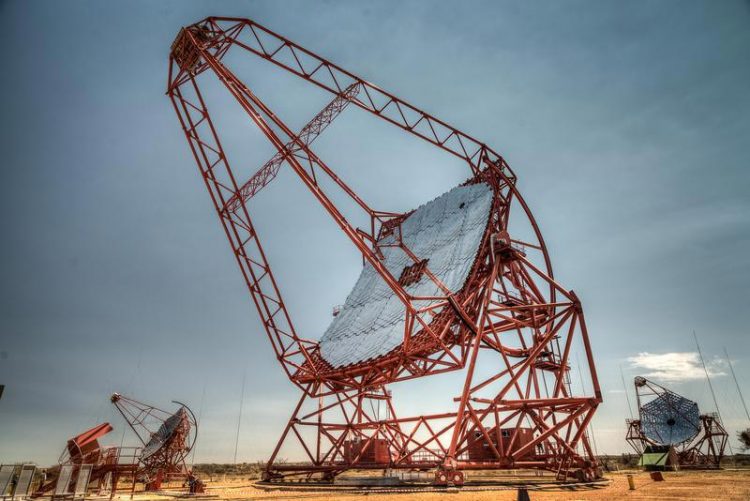First detection of gamma-ray burst afterglow in very-high-energy gamma light

The huge central H.E.S.S. telescope with 614 m² mirror area and two of the four smaller telescopes, each with 107 m² mirror area. MPIK/C. Föhr
On 20 July 2018, the Fermi Gamma-Ray Burst Monitor and a few seconds later the Swift Burst Alert Telescope notified the world of a gamma-ray burst, GRB 180720B. Immediately after the alert, several observatories turned to look at this position in the sky. For H.E.S.S. (High Energy Stereoscopic System), this location became visible only 10 hours later. Nevertheless, the H.E.S.S. team decided to search for a very-high-energy afterglow of the burst.
Extremely energetic cosmic explosions generate gamma-ray bursts (GRB), typically lasting for only a few tens of seconds. The burst is followed by a longer lasting afterglow in the optical and X-ray spectral regions whose intensity decreases rapidly. The prompt gamma-ray emission is mostly composed of photons several thousand to millions of times more energetic than visible light, that can only be observed by satellite-based instruments. Whilst these space-borne observatories have detected a few photons with even higher energies, the question if very-high-energy gamma radiation (at least 100 billion times more energetic than visible light) is emitted, has remained unanswered.
This radiation has now been detected with the large H.E.S.S. telescope, that is especially suited for such observations. The data collected 10 to 12 hours after the gamma-ray burst showed a new point-like gamma-ray source at the position of the burst, which had disappeared in data taken another 18 days later. Physicists of the Max Planck Institute for Nuclear Physics (MPIK) in Heidelberg led the analysis of these data.
GRB 180720B was very strong and lasted for about 50 seconds – a relatively long duration indicating the death of a massive star. In this process, its core collapses to a rapidly rotating black hole. The surrounding gas forms an accretion disk around the black hole, with gas jets ejected perpendicularly to the disk plane creating the gamma-ray flashes.
The very-high-energy gamma radiation which has now been detected not only demonstrates the presence of extremely accelerated particles, but also shows that these particles still exist or are created a long time after the explosion. Most probably, the shock wave of the explosion act here as the cosmic accelerator. Before this H.E.S.S. observation, it had been assumed that such bursts likely are observable only within the first seconds and minutes at these extreme energies.
At the time of the H.E.S.S. measurements the X-ray afterglow had already decayed very considerably. Remarkably, the intensities and spectral shapes are similar in the X-ray and gamma-ray regions. There are several theoretical mechanisms for the generation of very-high-energy gamma light by particles accelerated to very high energies. The H.E.S.S results strongly constrain the possible emission mechanisms, but also present a new puzzle, as they request quite extreme parameters for the GRB as a cosmic accelerator.
Together with the observations of very-high-energy gamma radiation following later GRBs with MAGIC and again with H.E.S.S., this discovery provides deeper insights into the nature of gamma-ray bursts. Jim Hinton of the MPIK is enthusiastic about the new discovery: „For more than a decade, Cherenkov telescopes such as H.E.S.S. and MAGIC have searched for very-high-energy gamma radiation from GRBs and continuously improved their observation strategies. Now several GRBs have been detected at very high energies within a very short time, and the bursts are emitting at extreme energies for many hours and even days. This opens entirely new perspectives for the successor instrument CTA (Cherenkov Telescope Array), which will enable us to study these stellar explosions in much more detail.“
Edna L. Ruiz Velasco
Phone: +49 6221 516-137
E-Mail: Edna.ruiz(at)mpi-hd.mpg.de
Dr. Daniel Parsons
Phone: +49 6221 516-634
E-Mail: daniel.parsons(at)mpi-hd.mpg.de
Prof. Dr. Werner Hofmann
Phone: +49 6221 516-330
E-Mail: werner.hofmann(at)mpi-hd.mpg.de
Prof. Dr. Jim Hinton
Phone: +49 6221 516-140
E-Mail: jim.hinton(at)mpi-hd.mpg.de
H.E.S.S. Collaboration (E. L. Ruiz Velasco, Q. Piel, R. D. Parsons, E. Bissaldi, C. Hoischen, A. M. Taylor, F. Aharonian, D. Khangulyan et al.): A very-high-energy component deep in the Gamma-ray Burst afterglow, Nature 575, 464–467 (2019), DOI: 10.1038/s41586-019-1743-9
Media Contact
More Information:
http://www.mpi-hd.mpg.deAll latest news from the category: Physics and Astronomy
This area deals with the fundamental laws and building blocks of nature and how they interact, the properties and the behavior of matter, and research into space and time and their structures.
innovations-report provides in-depth reports and articles on subjects such as astrophysics, laser technologies, nuclear, quantum, particle and solid-state physics, nanotechnologies, planetary research and findings (Mars, Venus) and developments related to the Hubble Telescope.
Newest articles

Properties of new materials for microchips
… can now be measured well. Reseachers of Delft University of Technology demonstrated measuring performance properties of ultrathin silicon membranes. Making ever smaller and more powerful chips requires new ultrathin…

Floating solar’s potential
… to support sustainable development by addressing climate, water, and energy goals holistically. A new study published this week in Nature Energy raises the potential for floating solar photovoltaics (FPV)…

Skyrmions move at record speeds
… a step towards the computing of the future. An international research team led by scientists from the CNRS1 has discovered that the magnetic nanobubbles2 known as skyrmions can be…





















